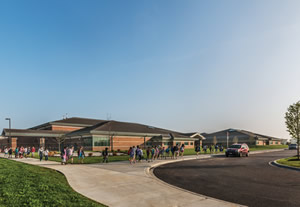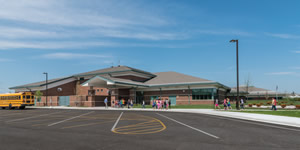The K-12 Parking Puzzle
- By Michael Fickes
- 07/01/17

PHOTO COURTESY OF FANNING HOWEY
Over the years, parking needs at K-12 schools have changed dramatically. One major change is that cars have gotten bigger, while parking spaces have not. Spaces have, by and large, remained the same size. “A traditional parking stall measures 10 feet by 20 feet,” says Stephan C. Howick, RLA, LEED-AP, a landscape architect with Fanning Howey, an architectural and engineering firm with several specialties including K-12 schools and institutions of higher education.
Despite larger vehicles, a few schools have reduced the size of parking spaces. “Some districts have cut the size of the parking spaces down to 9-feet-by-18-feet,” continues Howick. “The State of Ohio calls for 9-feet-by-19-feet spaces.”
Liability Concerns
At some schools, drivers picking students up at the end of the day may need temporary parking spaces.
At other schools, drivers don’t park. Instead they drive by the front of the school or another designated area, and their children hop in.
Either way, school officials must make sure that the driver picking a student up is authorized to make the pickup. That is especially important for younger elementary students.
Tim Armstrong, principal at the Albany Elementary School in Albany, Ky., has developed a way to tightly manage after school pick-ups by parents or designated drivers.
He describes the management problem this way: “We have 500 kids in our school, with 2,200 people authorized to pick up those children: they are married, divorced and on visitation schedules.
Armstrong’s system eliminates the need to park.
“We’ve developed a drive-through system,” he says. The parents (or the person authorized to make the pickup) stay in the car and hold out an ID tag that says who the person is, the name of the student and which days he or she is authorized to pick that student up.
“You must develop an organized system like this or you might make a mistake, which can create liability. Suppose you are a principal supervising parents picking up students after school. Someone may approach you, and tell you that John is supposed to come home with him today. John has been invited to a birthday party, says the person. If you let them drive off together and there is an accident (or worse), you may be liable.
“So, we have a strict system to manage who may pick up students.”
How does this affect parking? If parents don’t have to park and come into the school to pick up children, a school can get by with fewer parking spaces.

PHOTO COURTESY OF FANNING HOWEY
Overstriping: A school’s parking lot can do double duty when you overlay one parking configuration for buses and one for visitors and staff by overstriping, like in the photo above. Another concern, brought about by the increase in parents driving their kids to school, is the potentially hazardous practice of cars queuing on public streets. To avoid this, make sure your parking lots and drop off lanes are large enough to accommodate the traffic.
On the other hand, some drop off systems can increase the need for temporary parking. For first-through-third-grade students, for instance, parents often want to drive their children to school, walk them into the building and check them in for the day, says Jim LaPosta, a principal and chief architectural officer with JCJ Architecture. Some schools even require this for the younger students. That creates a need for temporary parking.
Parking Spaces for Schools
When planning parking, elementary school planners typically focus on use by staff during the day, plus a few visitors, observes LaPosta. District officials often try to avoid spending money to build parking lots that can accommodate events, observes LaPosta. But it really is important to consider events in design. A big school event at a school with inadequate parking will cause cars to spill out onto the public road and create a safety hazard.
“But it really is important to consider all issues that affect parking needs for K-12 schools, including large events” says LaPosta. “Schools host sporting events, conferences, PTA meetings and so on. You must also factor such events into estimates of parking needs.
“In addition, high schools need parking space to accommodate students who drive to school. Some districts manage student parking with policies that limit the numbers of students who can drive.”
One way to limit student drivers is to provide parking areas that are fenced off and require card access. That will encourage those without access cards to take the bus.
Another issue: it is important not to overestimate parking needs. Taxpayers pay attention to projects built with their taxes, LaPosta says. If they drive by a school with a parking lot that is mostly empty, they will notice and take it into consideration the next time they are approached about funding needs.
Parking Lot Design
Once there is a solid estimate of how much parking is needed, design considerations come into play.
First, where will you put the parking lot? LaPosta point out a chilling consideration. Since the Sandy Hook shooting and other tragedies experienced in schools, he says, access to parking and the location of parking lots are part of the safety planning for a school.
“At Sandy Hook, the criminal drove right up to the front door of the school,” LaPosta points out. “In light of that, a good rule to follow is to position parking so that it takes time to get from the parking area to the front door.
“Another benefit of such a design — which keeps car parking away from the front of the building — is that it enables first responders in police cars or fire trucks to access the building. They can drive right up the front door.”
LaPosta also notes that by placing the lot a distance away, but still in full view of the front door, the front office and cameras at the front of the building can observe the parking area and perhaps identify trouble before it can get to the front door.
Another design consideration involves separating the parking areas used by teachers, students and visitors. Today, these areas are often physically separated. “The real concern here is visitors,” LaPosta says. “It’s important to be able to see people who don’t belong in the building and to make sure they don’t enter.
“This is all about preventing and deterring trouble. We want people to feel like someone is watching. It isn’t always about someone with a gun, either. Today, in schools with young children, officials must be sensitive to custody battles. Distance helps with that. If a non-custodial parent comes to school to see his or her child, sufficient distance out front provides time to react appropriately — to prevent trouble.”
SCHOOL BUSES NEED PARKING, TOO
School buses, too, need parking place to facilitate picking up and dropping off. “Buses, like cars, are getting larger today,” says Stephan C. Howick, RLA, LEED-AP, a landscape architect with Fanning Howey.
According to Howick, today’s buses can carry 70 students. Bigger buses mean fewer buses on the road — a safety consideration. Bigger buses also mean fewer buses to maintain, which lowers operating costs.
“Even so, we need adequate space for buses to drop off and pick up in school parking lots. That requirement calls attention to the important differences between the way buses work in the morning and afternoon.
“In the morning, buses do curbside drop off. There is no sequence to busing in the morning. The buses arrive when they arrive, and the students get off.
In the afternoon, however, when students are going home, the buses line up, always parking in the same places. The kids know where to go to find their own buses.”
In Howick’s district, the buses waiting to pick up students after school line up at a diagonal to the curb, but they remain far enough away from the curb to enable them to pull out forward — without backing up. “I think that setting up bus parking so that buses only move forward, never backward, is pretty standard operating procedure across the country,” Howick says. “I would recommend that districts that don’t have such a procedure consider adopting it.
“And when the buses leave the property in the afternoon, they pull off the property in a parade, stopping traffic. We do that because the faster the buses are on the road, the faster the kids get home.”
So, bus accommodations in school designs need to include areas for dropping off and picking up. But buses also need overnight parking accommodations, which district transportation facilities can often accommodate.
This article originally appeared in the issue of .